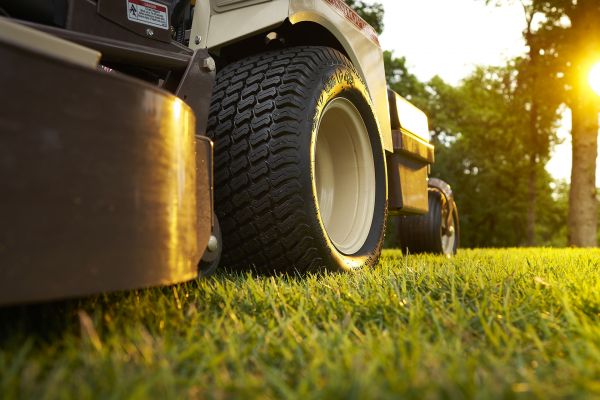Mower tire pressure: are you overlooking an important quality of cut factor?
Posted on:Mar 27, 2024

If you wait until a mower tire is obviously deflated before checking the tire pressure, you’re missing out on a critical and simple maintenance step that improves quality of cut, comfort, fuel efficiency and overall performance.
We usually think about sharpening blades, cleaning the mower deck and proper cutting deck height as musts for achieving the best cutting results. But proper tire pressure is often overlooked, and it’s more important than you might realize. You can do everything else right on the maintenance checklist, but if you ignore tire pressure, the turf will tell the story by way of an uneven or butchered cut. Upset customers will be disappointed in the service. Not to mention, replacing damaged tires can be a costly and unnecessary business expense.
Maximize the life of mower tires, spend less on fuel and reduce downtime by checking PSI regularly and addressing underinflated mower tires before they become a liability.
Up and down: what affects mower tire pressure?
Mower tire pressure fluctuates depending on the outdoor air temperature and mower use. Cold temperatures cause tire pressure to drop slightly. However, tires warm up when your mower is in use, which boosts air volume and increases tire pressure. These are important factors to understand because you can expect lower pressures on cooler days or during shoulder seasons when temperatures rise and fall significantly within a day’s time. On the other hand, tire pressure rises after operating your mower.
>>The Takeaway: Check mower pressure before your daily route, when the mower is cool and you can gather an accurate PSI reading.
Inflated for quality of cut
Low tire pressure can affect steering, resulting in an unstable ride that impacts cutting appearance. If tires are inflated to varying PSI levels, the mower could scalp areas of the lawn while leaving some swaths of turf longer — an unmanicured look that will typically lead to customer complaints and hurt your business’s reputation.
Also, when tire pressures are inconsistent, the cutting deck sits unevenly and can lack the airflow to disperse clippings, causing clumping and a mess to clean up, adding more labor hours to the equation.
>>The Takeaway: When tires are properly inflated, you will achieve an even, quality cut. Be sure to check tire pressure on a level surface to get accurate readings.
Tire pressure and operator comfort
When mower tires are overinflated, you’ll experience a rough ride with too much bounce, which can be tiresome and lead to operator fatigue. With long hours on a mowing schedule and a business to run, comfort is not a luxury. It’s an ergonomic necessity, and tire pressure has a lot to do with how smoothly a mower glides over a property’s bumps and manages varying grades. Not to mention, tire pressure affects traction, another mower safety concern that is easily addressed by regularly checking mower tire PSI.
>>The Takeaway: Your Grasshopper mower is equipped with ergonomic features designed to deliver a smooth ride, precise control and a manicured finish. Proper tire pressure is essential for realizing these benefits.
Extend mower longevity
Maintaining proper tire pressure and putting on the right type of tires for your application extends mower life. Grasshopper uses low pressure tires to ensure proper traction, better ride quality, and less wear and tear on the hydraulic system of your mower. By putting less stress on your hydraulic system, you improve the fuel economy of the machine. This allows you to extend mowing time. Depending on your application, a tire sealant, non-flat tires or Tweels will help extend your mower tire life for rough terrain.
>>The Takeaway: Maintaining manufacturer-recommended tire pressure will increase the longevity of your mower, reduce fuel expenses and result in lower operating costs. Inflate to the optimum pressure recommended in your owner’s manual, not to the maximum pressure embossed on the tire.
Keep an eye on tire pressure and manage in-season maintenance
Tire pressure usually isn’t the first thing that comes to mind related to quality of cut, fuel efficiency, operator comfort and mower safety. But proper tire PSI plays a crucial role in maximizing your performance and getting the most from your equipment investment.
Interested in more mowing tips from the pros at Grasshopper? Check out our library of how-to videos, or sign up for our newsletter. Thinking about a new mower? Our team can help you choose the best model for your needs.

